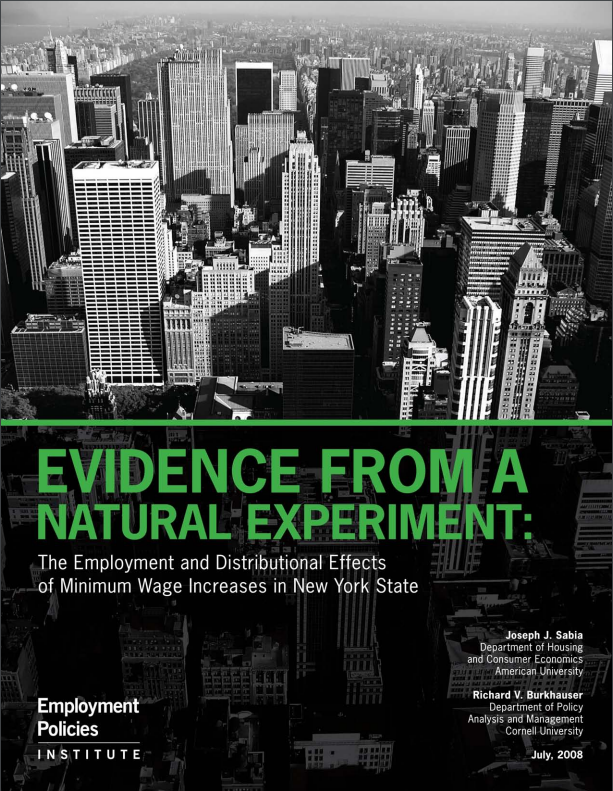In June 2007, New York State Assembly Speaker Sheldon Silver proposed legislation to raise the state minimum wage from $7.15 to $8.25 per hour, and to index it to inflation thereafter. Proponents argue that such minimum wage increases have no negative employment effects (Card and Krueger, 1995; Dube et al., 2008) and will be effective in aiding poor workers,[1] while opponents emphasize the minimum wage’s poor target efficiency (Burkhauser and Sabia, 2007) and non-trivial adverse employment and hours effects for low-skilled workers (Neumark and Wascher, 2007). While forecasting the behavioral and distributional consequences of a proposed state minimum wage hike can prove difficult, the case of New York provides a unique opportunity to do so. This is because Speaker Silver’s new proposal comes on the heels of New York’s recent experience with an increase in the state minimum wage. We seek to simulate the employment and distributional effects of the newly proposed state minimum wage hike by using estimates obtained from the last increase.
The timing of the last minimum wage hike in New York provides the key to identifying its effect on low-skilled workers. In 2004, the New York State legislature overrode Governor George Pataki’s veto and raised the state minimum wage from $5.15 to $7.15 per hour. The wage hike was implemented in three phases: from $5.15 to $6.00 per hour on January 1, 2005; from $6.00 to $6.75 on January 1, 2006; and finally from $6.75 to $7.15 on January 1, 2007.[2] In a window between 2004 and 2006, three border or near-border states—Pennsylvania, Ohio, and New Hampshire—did not change their minimum wages from $5.15 per hour. Thus, focusing on New York’s minimum wage increase from $5.15 in 2004 to $6.75 in 2006 permits the construction of a comparison group of low-skilled individuals in Pennsylvania, Ohio, and New Hampshire that were not directly affected by minimum wage increase. Moreover, we rely on more highly-educated or experienced workers to serve as a within-state comparison group. The use of both cross-state and within-state comparison groups permits a difference-in-difference-in-difference (DDD) identification strategy, which will compare relative employment trends between low- and high-skilled individuals in New York with such trends in comparison States. We then use our estimates of the labor demand effects of the 2004-2006 New York minimum wage increase to simulate the employment and distributional consequences of the proposed hike to $8.25 per hour.
Using data from the 2004 and 2006 Current Population Survey (CPS) outgoing rotation groups, we first estimate the effects of New York’s minimum wage hike from $5.15 to $6.75 per hour on 16-to-29 year-olds without a high school degree. We find that the increase in the minimum wage reduced the share of these low-skilled workers who earned between $5.15 and $6.74 per hour and increased the share earning $6.75 per hour. Our results also show consistent evidence of large adverse employment effects. We find that the 31.1 percent increase in the New York minimum wage was associated with a 12.2 to 36.5 percent decline in employment of less-educated 16-to-29 year olds. These effects imply an employment elasticity of –0.4 to -1.2, with a median elasticity estimate of approximately -0.8. We find less consistent evidence that raising the minimum wage affected work hours among retained workers.
Our employment estimates are robust to the choice of comparison States, the choice of within-state comparison groups, and to the inclusion of a number of control variables. Moreover, the credibility of our identification strategy is bolstered by the results of falsification tests, which show that relative employment trends between low-skilled and high-skilled individuals in New York did not fall faster than comparison States in the period prior to the passage of the minimum wage increase (2002-2004) or when comparison States also raised their minimum wage (2006-2007).
Finally, we use our employment and hours estimates from the last minimum wage increase, along with more conservative estimates from the existing literature, to simulate the employment and distributional effects of the proposed New York minimum wage hike from $7.15 to $8.25 per hour. Using conservative employment elasticities, we estimate that over 16,000 jobs will be lost. When we simulate the distribution of monthly benefits from this minimum wage hike, we find that just 20 percent of the benefits will go to workers in poor households. At average employment elasticities greater than -0.89—which are not implausible given the range of estimates we obtain—poor working households will suffer, on net, monthly labor earnings losses from the proposed minimum wage hike. We conclude that other policy tools, such as expansions in the New York State Earned Income Tax Credit (EITC) program, are likely to be more effective at promoting employment and increasing incomes of low-skilled poor workers.
